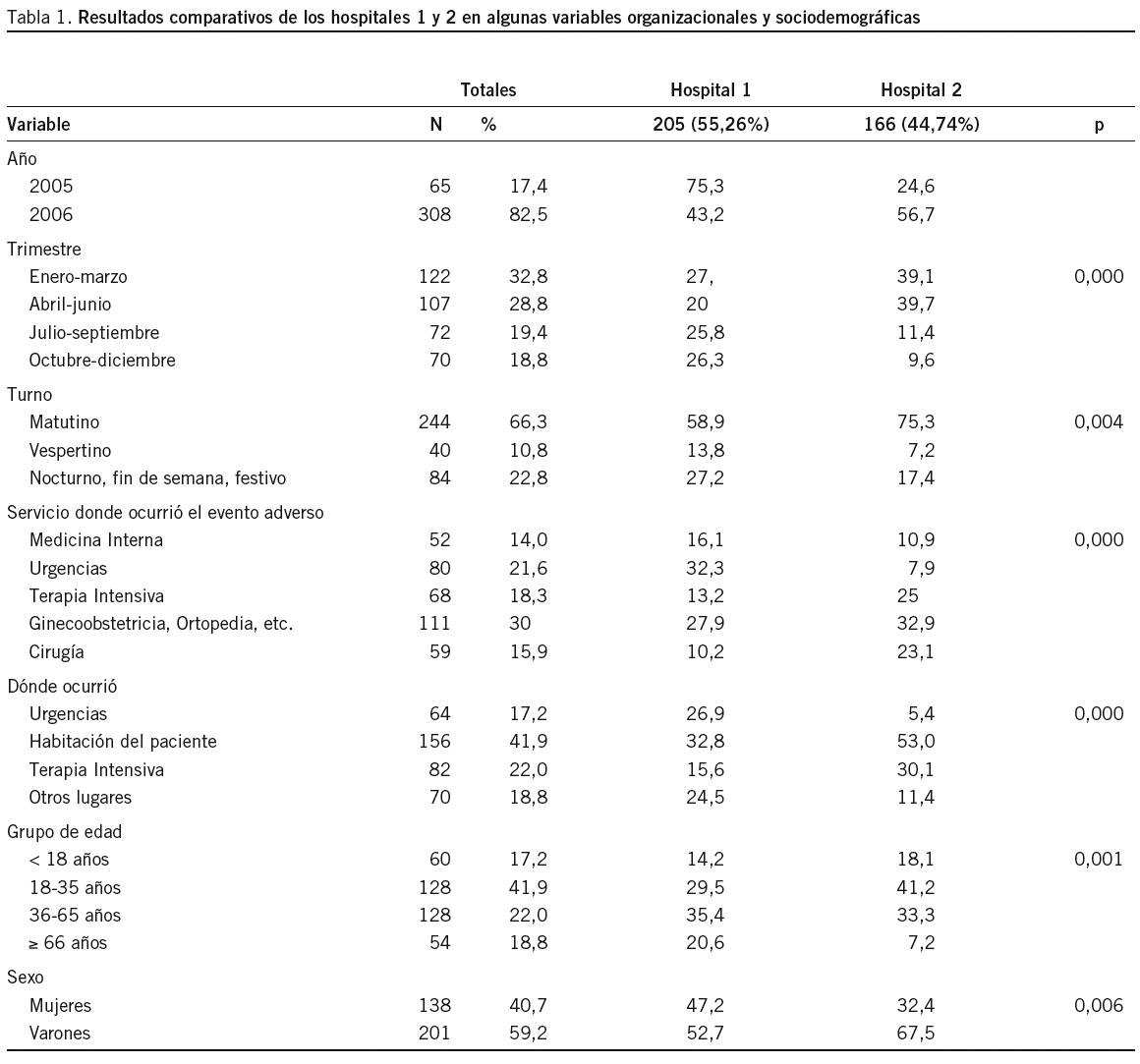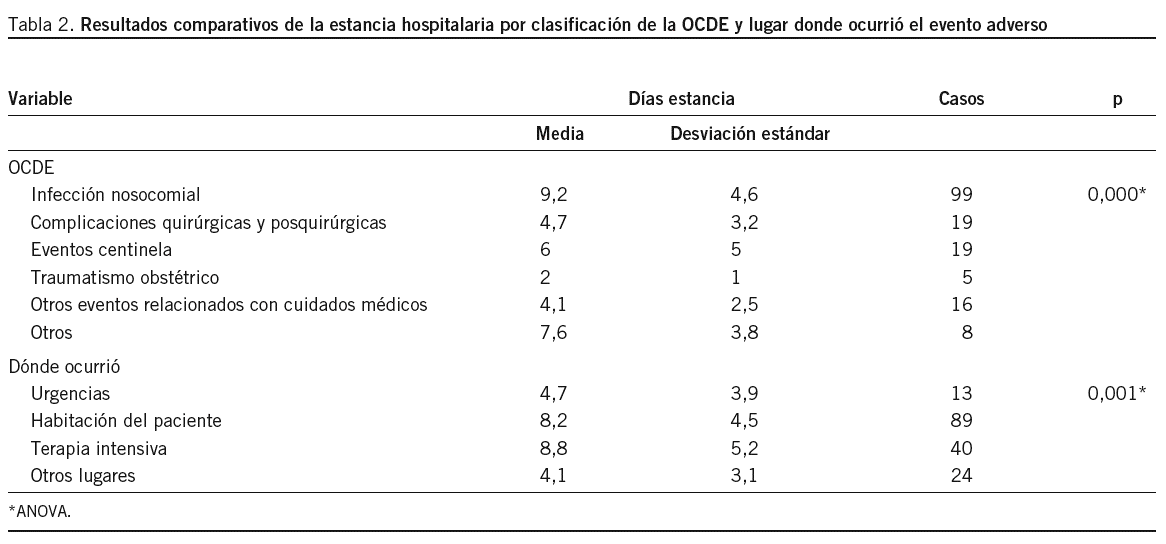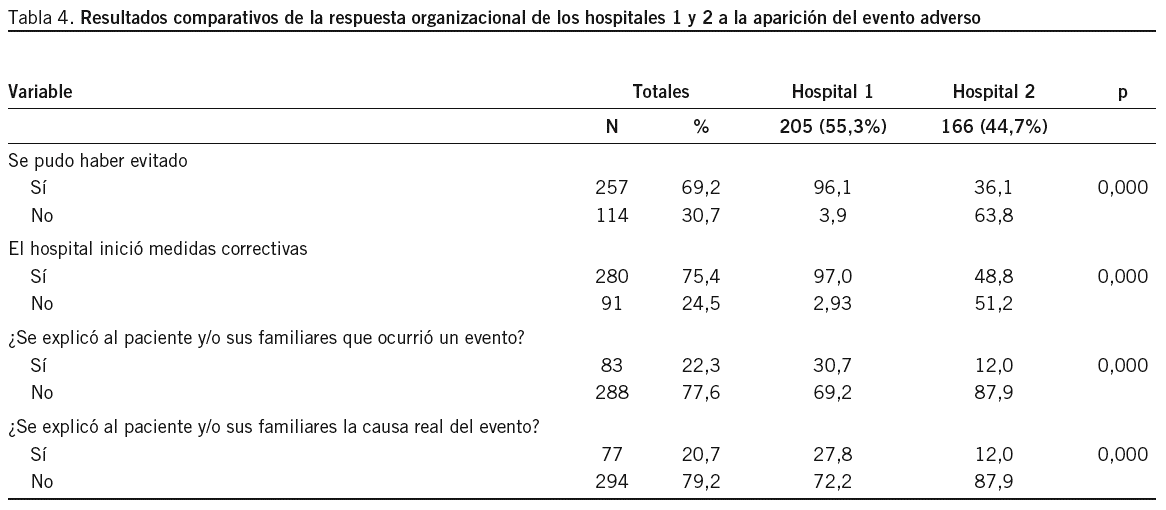Journal Information
Vol. 22. Issue 6.
Pages 342-349 (November 2007)
Vol. 22. Issue 6.
Pages 342-349 (November 2007)
Full text access
Análisis comparativo hospitalario del evento adverso en México: utilidad del reporte voluntario en línea
Comparative analysis of adverse events in two hospitals in Mexico: utility of voluntary on-line
Visits
4792
This item has received
Article information
Objetivo: Análisis comparativo del reporte en línea de eventos adversos al Sistema Nacional de Registro y Aprendizaje de Eventos Centinela (SiNRAECe) de dos hospitales generales durante 2005 y 2006. Material y método: Análisis retrospectivo de la base de datos contenida en el SiNRAECe, de octubre de 2005 a diciembre de 2006, de dos hospitales generales. Se contó con 371 registros, la totalidad de ese período. Se realizó el análisis mediante comparación de proporciones (x2), ANOVA y cálculo de riesgo expresado en odds ratio, y se consideró significativa la diferencia cuando p # 0,05. Resultados: Se encontraron diferencias significativas entre los hospitales comparados respecto a los siguientes aspectos: aparición de eventos adversos (EA) en urgencias (el 32,3 y el 7,9%; p # 0,001); se ocasionó o se pudo ocasionar un daño con pérdida permanente de funciones o muerte (el 22,7 y el 46,7%; p # 0,001); EA clasificado como infección nosocomial (el 57,8 y el 4,3%; p # 0,001); opinión de que el EA era evitable (el 96,1 y el 36,1%; p # 0,001), y acciones correctivas (el 97 y el 48,8%; p # 0,001). En el hospital 2, la probabilidad de un EA que causara daño fue 2,4 veces mayor que en el hospital 1 (p = 0,001; intervalo de confianza del 95%, 1,4-4,2). Conclusiones: El reporte en línea facilita la comparación de los casos de EA hospitalarios, tanto en su frecuencia como en las condiciones organizacionales que pudieran identificar las áreas de riesgo, y ayuda a identificar áreas de oportunidad de mejora en los procesos. La información derivada del análisis de dicha información será útil para la toma de decisiones en la gerencia hospitalaria.
Palabras clave:
Evento adverso
Seguridad del paciente
Hospitalización en México
Objective: We performed a comparative analysis of the on-line reports of adverse events made to the National Sentinel Event Registration and Learning System (SiNRAECe) by two general hospitals in 2005 and 2006. Material and method: A retrospective analysis of the database contained in the SiNRAECe from October 2005 to December 2006 from two general hospitals was performed. There were a total of 372 records in this period. Analysis was performed by means of proportion comparison (x2), ANOVA and risk calculus expressed in odds ratio. Significance was set at p # 0,05. Results: Significant differences were found between the two hospitals in the following variables: the occurrence of adverse events (AE) in the emergency department (32.3 vs. 7.9%; p # 0.001); the occurrence or possible occurrence of death or injury with permanent loss of function (22.7% vs. 46.7%; p # 0.001); AE classified as in-hospital infection (57.8% vs. 4.3%; p # 0.001); the opinion that the AE were preventable (96.1% vs. 36.1; p # 0.001), and corrective actions (97% vs. 48.8%; p # 0.001). In hospital 2, the probability of having an AE causing injury was 2.4 times greater (p # 0.001; 95% confidence interval, 1.4-4.2) than in hospital 1. Conclusions: On-line reporting facilitates comparison of the occurrence of in-hospital AE, both their frequency and the organizational conditions that could identify the risk areas. Likewise, this system helps to identify opportunities for improvement. Information derived from analysis of these data will be useful in decision making in hospital management.
Keywords:
Adverse event
Patient safety
Hospitalization in Mexico
Full text is only aviable in PDF
Bibliografía
[1]
Brennan TA, Leape LL, Laird NM, Hebert L, Localio AR, Lawthers AG, et al..
Incidence of adverse events and negligence in hospitalized patients. Results of the Harvard Medical Practice Study I..
N Engl J Med, 324 (1991), pp. 370-6
[2]
Steel K, Gertman PM, Crescenzi C..
Iatrogenic illness on a general medical service at a university hospital..
N Engl J Med, 304 (1981), pp. 638-42
[3]
Baker RG, Norton PG, Flintoft V, Blais R, Brown A, Cox J, et al..
The Canadian Adverse Events Study: the incidence of adverse events among hospital patients in Canada..
CMAJ, 170 (2004), pp. 1678-86
[4]
To err is human: building a safer health system. Washington: National Academy Press; 2000.
[5]
Gawande AA, Thomas EJ, Zinner MJ, Brennan TA..
The incidence and nature of surgical adverse events in Colorado and Utah in 1992..
Surgery, 126 (1999), pp. 66-75
[6]
Bates DW, Spell N, Cullen DJ, et al..
The costs of adverse drug events in hospitalized patients..
JAMA, 277 (1997), pp. 307-11
[7]
Johnson WG, Brennan TA, Newhouse JP, et al..
The economic consequences of medical injuries..
JAMA, 267 (1992), pp. 2487-92
[8]
Leape LL..
Reporting of adverse events..
N Engl J Med, 347 (2002), pp. 1633-8
[9]
2 del Decreto de Ley Federal de Transparencia y Acceso a la Información Pública Gubernamental publicada en el DOF el 11 de junio de 2002.
[10]
Paris: OECD; 2004.
[11]
Relationship between adverse events and complaints received by the national commission medical arbitration throughout 2004. 23rd ISQua International Conference. Londres, 22-25 de octubre de 2006.










